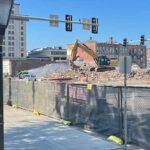On a scorching hot day in mid-July, prolonged flooding on the Mississippi River that weaves along the eastern border of Iowa may seem like a bad but distant dream. But the swollen waterway that put the spotlight on Davenport this spring continues to wreak havoc as far away as Louisiana. The city of New Orleans has been at flood stage for more than 200 days! People in that vulnerable city lost sleep this past weekend as they awaited the outcome of a tropical storm, combined with torrential rains filling an already saturated river. We are connected to one another; as a people, as a planet.
Some might claim that an act of God created the flooding, not we human beings. But we are responsible for the choices in our daily lives that exacerbate flooding: our desire for meticulously manicured lawns; farmland being converted to housing and shopping developments; agricultural tiling that flushes the water, preventing it from being absorbed and cleansed; and the loss of wetlands that act as natural sponges. Furthermore, our use of nutrients such as nitrogen and phosphorus on our lawns, in our sewage treatment plants and on our farmland contribute to the “Dead Zone” in the Gulf of Mexico. These nutrients “choke off oxygen in water and make it difficult, if not impossible, for marine life to survive” (The Nature Conservancy, https://tinyurl.com/yxcon4k6 /). We are connected to one another; as a people, as a planet.
Last week, Davenport Mayor Frank Klipsch opened the first meeting of the Flood Task Force, a broad-based group of residents, business owners, elected officials, developers and experts in the Mississippi River, flooding and weather-related fields. The work of this task force should matter to all of us because what happens along the river in Davenport impacts people upstream and downstream. We are connected to one another; as a people, as a planet.
During that first meeting on July 9, Mayor Klipsch said the group would look at “What do we protect and how do we prioritize what we protect? … What does shared responsibility look like?” Ultimately, he envisions development of a “world-class riverfront” that fosters protection of the environment and Mississippi River corridor and a vibrant business area.
Therein lies the challenge: balancing the need to protect people and businesses with care for God’s good earth: land, water and air. Catholic teaching views care for creation as a moral issue. “Protecting the land, water, and air we share is a religious duty of stewardship and reflects our responsibility to born and unborn children, who are most vulnerable to environmental assault” (“Forming Consciences for Faithful Citizenship,” www.usccb.org.). We are connected to one another; as a people, as a planet.
Just about every time it floods in Davenport, debate begins anew about whether the city should build a flood wall. But we must consider the ramifications for people downstream. A National Public Radio report (All Things Considered, May 21, 2018) noted an increase in the severity and frequency of flooding on the Mississippi River and that earthen levees make the problem worse. “Levee hazards are not a new idea. In 1852 an engineer named Charles Ellet Jr. wrote a report for the federal government in which he warned that confining the Mississippi River to a narrow channel caused the water to ‘rise higher and flow faster’” (https://tinyurl.com/y3c9vcmx).
As faithful citizens and stewards of God’s creation, we have an obligation to work together to develop solutions that nurture our earth and sustain it for future generations. In his encyclical, “Laudato Si” (Praise Be to You, On Care for Our Common Home), Pope Francis says “We need a conversation which includes everyone, since the environmental challenge we are undergoing, and its human roots, concern and affect all of us” (No. 14). We are connected to one another; as a people, as a planet.
So, where do we begin?
• Obtain a copy of “Laudato Si” and read it, to become grounded in an understanding about our relationship with God, with one another and with all of creation.
• Learn about the importance of wetlands at the USDA Natural Conservation Resources Service (https://tinyurl.com/y6oqwa4j).
• Ask Senators Joni Ernst (www.ernst.senate.gov) and Charles Grassley (www.grassley.senate.gov) and your U.S. representative to support restoration of wetlands. Convince them to urge President Trump to rejoin the Paris Agreement to mitigate climate change.
• Visit the City of Davenport website to view the first meeting of the Flood Task Force (https://tinyurl.com/y6kmrpot) and a list of its members.
• Farmers can slow down moving water on their property by making room for wetlands. Lobby for financial incentives that take land permanently out of production that shouldn’t have been in production in the first place.
• Use fewer chemicals — in crop production or on lawns.
• If you are a homeowner, create a miniature wetland or prairie on your property and put a border around it so your neighbors recognize it as an intentional part of your landscape.
• Visit the prairie at St. Ambrose University in Davenport, which has become an attractive feature on campus.
• Encourage your local government to create small storm water pools in park-like settings to slow down the flow of water into the river.
• Pray that more of us will embrace our role as stewards of God’s creation. We are connected to one another; as a people, as a planet.
Barb Arland-Fye, Editor
(arland-fye@davenportdiocese.org)











